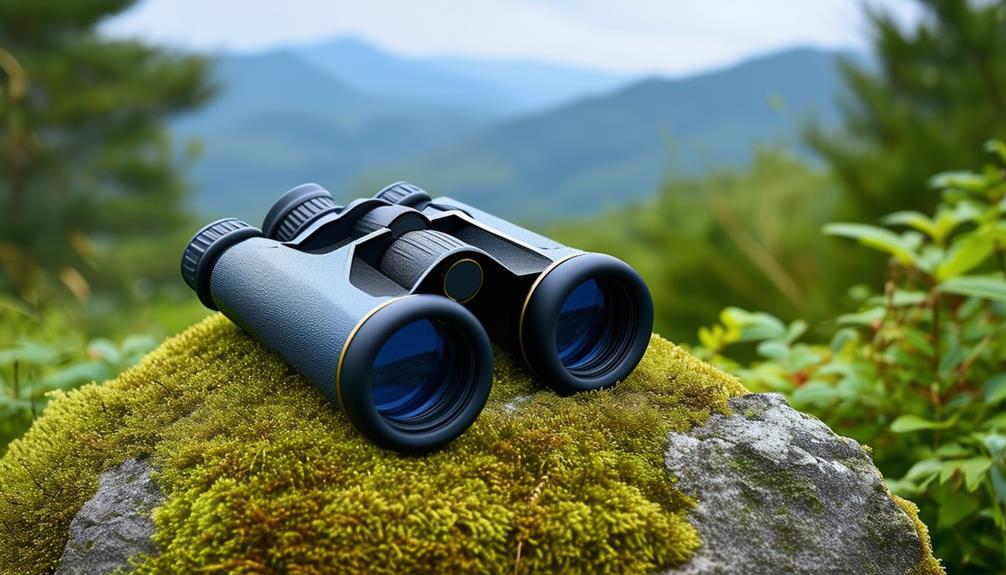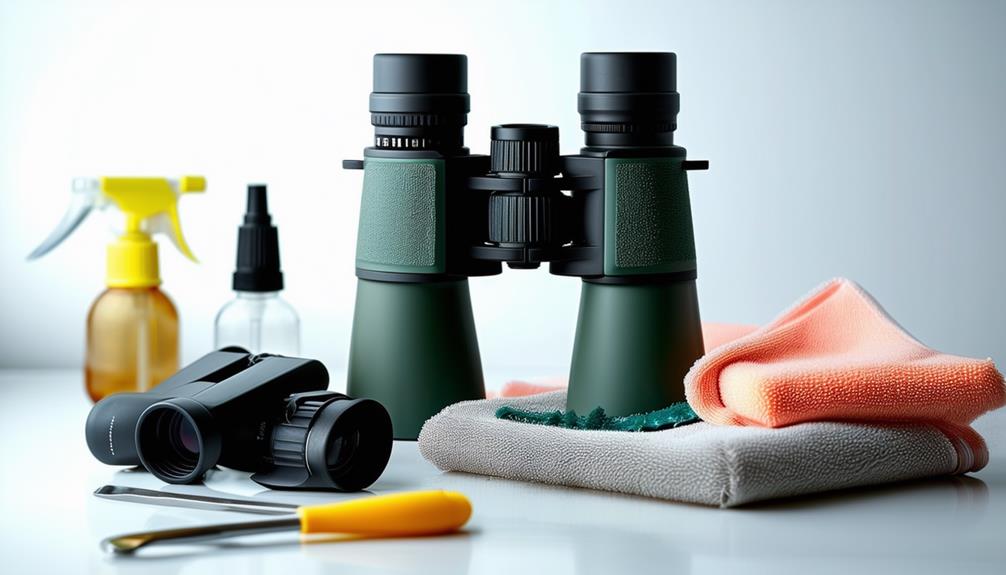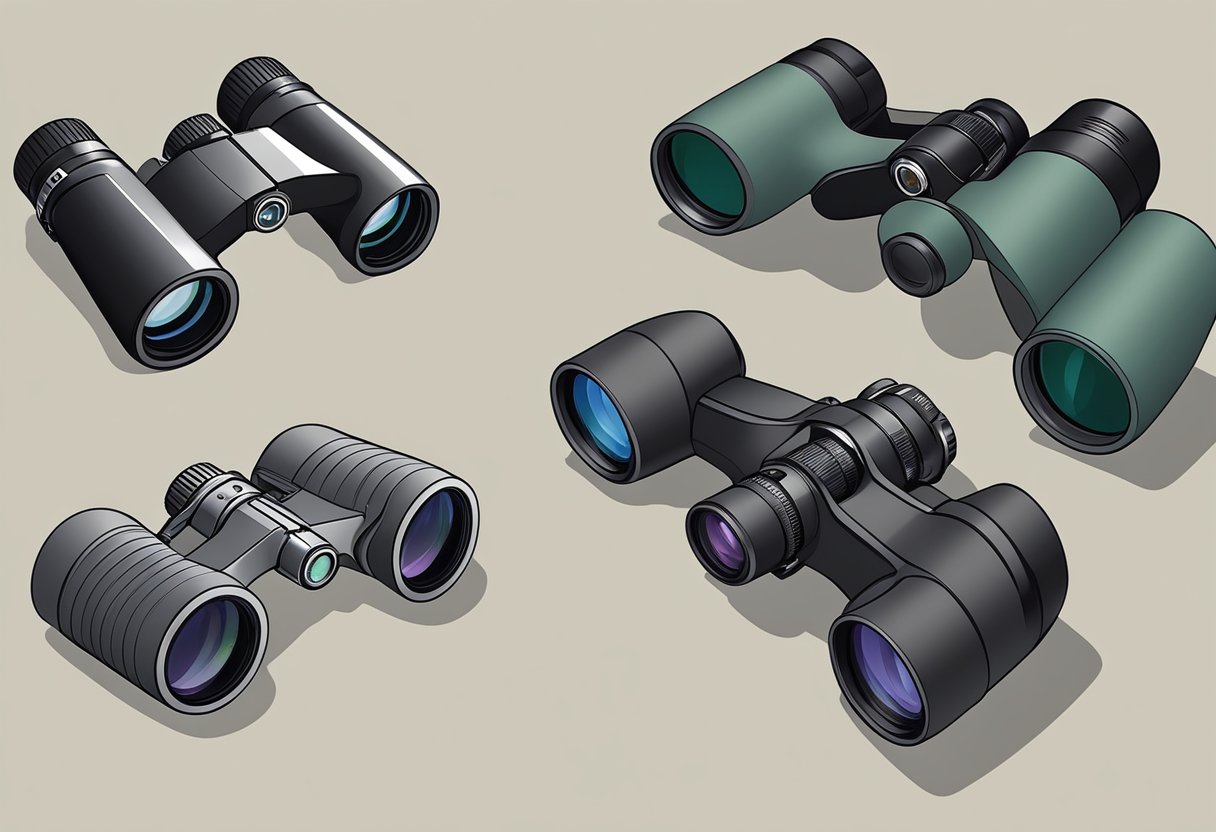How to Adjust Binoculars for Optimal Viewing Comfort
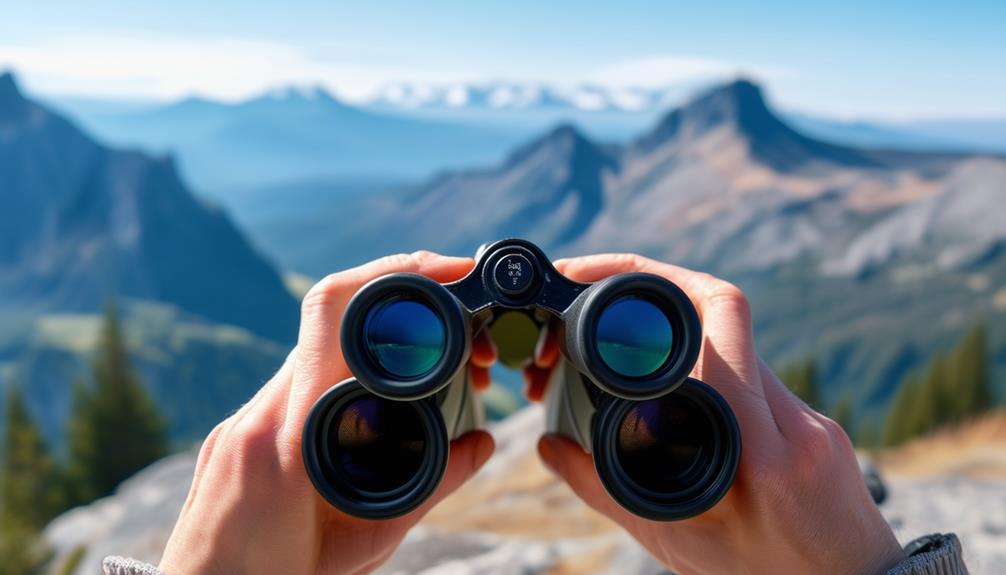
To adjust your binoculars for optimal viewing comfort, start by setting the eye cups to match your use of glasses, if applicable. This simple step can significantly enhance your viewing experience.
Next, align the binocular width to suit your eye distance properly. Adjusting the diopter for each eye ensures clarity and sharpness in your image. But the process doesn't stop there. Are you interested in additional tips and adjustments to elevate your binocular use to the next level? Let's delve into those critical enhancements.
Adjusting the Eye Cups
To ensure comfort and a clear image, adjust the eye cups based on whether you wear glasses. If you wear glasses, turn or flip the eye cups down to bring the lenses closer to your eyes. Without glasses, extend the eye cups to maintain the correct distance for comfortable viewing.
Proper adjustment is crucial for achieving accurate eye alignment with the binoculars. Misaligned eye cups can result in an incomplete image and discomfort, negatively impacting your viewing experience. Adjust the eye cups by moving them closer or further apart until you see a full, round image in both eyes.
Verify your adjustment by closing one eye at a time to ensure each eye sees consistently. If the image appears off or incomplete, readjust the eye cups. Correct alignment will enhance comfort and provide an optimal viewing experience.
Properly adjusted eye cups are essential for the comfortable and prolonged use of your binoculars. Don't skip this step; it's foundational for all other adjustments and ensures a clear, strain-free view.
Setting the Correct Width
To set the correct width, adjust the binoculars to match the distance between your eyes. This ensures a clear, round image and prevents eye strain. Close one eye at a time to verify that each eye has a consistent and sharp view.
Eye Distance Alignment
Adjusting the binoculars to match the distance between your eyes ensures a clear and comfortable view. Hold the binoculars up to your eyes and adjust the width by moving the eyepieces closer or further apart. Proper alignment will help you see a full, round image with both eyes open. Incorrect eye distance alignment can lead to discomfort and an incomplete image.
To fine-tune this adjustment, close one eye at a time. Look through the binoculars with your right eye closed, then your left eye closed. This ensures each eye receives a consistent view. If the images don't align, readjust the width until they do. This process, known as binocular prism adjustment, is essential for maintaining depth of focus and overall clarity.
Also, check the diopter setting to fine-tune the focus for each eye individually. Proper eye distance alignment, combined with the correct diopter setting, guarantees the best possible viewing experience. Taking the time to adjust the width properly will make using your binoculars more enjoyable and visually satisfying.
Full Image View
Adjust the width of your binoculars until you see a single, full, and round image through both eyes. This step is essential for achieving a comfortable and clear view. To start, hold the binoculars up to your eyes and move the barrels closer together or further apart to match the distance between your eyes. When done correctly, you should see one cohesive image without any strain.
Next, verify your adjustment by closing one eye at a time. Each eye should have a consistent and clear view. If one eye sees a different part of the image or if there's any discomfort, readjust the width until both eyes sync perfectly.
Proper width adjustment is crucial not only for clear vision but also for comfort. Incorrectly set binoculars can cause eye strain, especially during prolonged use. A well-adjusted width ensures your viewing experience is both enjoyable and comfortable.
Diopter Adjustment
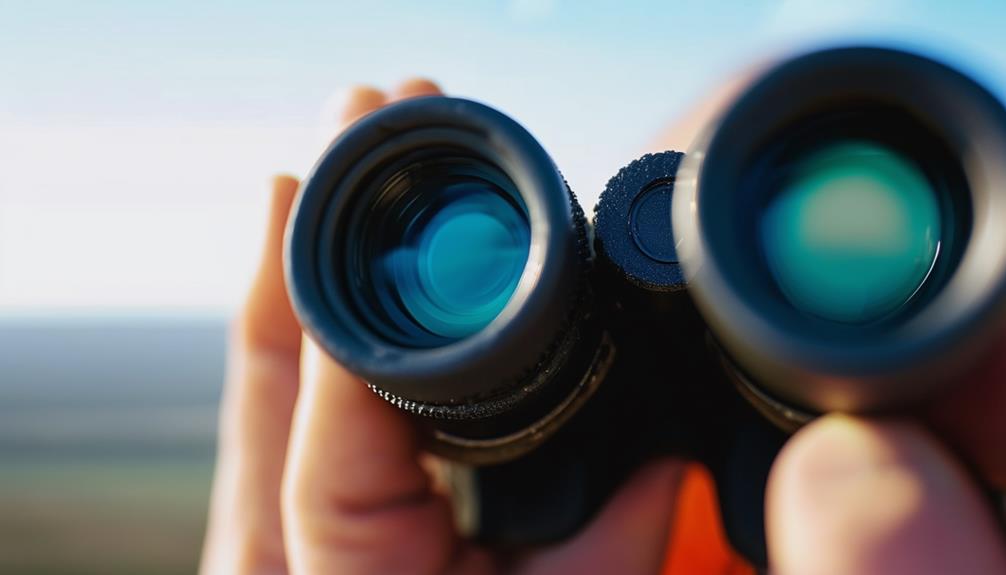
Diopter adjustment on your binoculars is crucial for compensating for vision differences between your eyes, ensuring a sharp image and comfortable viewing. Typically located on the right eyepiece or behind the focus button, this feature allows you to fine-tune each eye's focus separately.
To adjust the diopter:
- Close your right eye and use the central focus wheel to achieve a clear image through the left eyepiece.
- Close your left eye and adjust the diopter on the right eyepiece until the image is equally sharp.
This process balances your vision and reduces eye strain, especially during extended use. Proper diopter adjustment is particularly beneficial if you have different prescriptions in each eye. Once set correctly, it enhances eye relief, reduces fatigue, and improves your viewing experience.
Remember to check and readjust the diopter if others use your binoculars or if there are changes in your vision over time. Correct diopter settings ensure you get the best performance from your binoculars, providing clearer and more enjoyable views consistently.
Focusing Your Binoculars
After setting the diopter adjustment, the next step is to focus your binoculars for optimal clarity. Start by closing your right eye and using the center focus wheel to adjust the view for your left eye. Aim at a distant object and turn the wheel until the image is sharp and clear. This ensures your left eye is properly focused.
Next, close your left eye and open your right eye. Use the diopter adjustment, typically found on the right eyepiece, to bring the object into sharp focus for your right eye. Adjust this slowly until the image is as clear as possible. This step ensures each eye is focused independently, providing optimal clarity.
Once both eyes are adjusted, open them and use the center focus wheel to fine-tune the overall image. This final step ensures that both eyes are working together comfortably, allowing you to enjoy a clear and sharp view of the object. Remember to keep the diopter setting at zero when not in use to avoid discrepancies in your vision.
Fine-Tuning the Focus
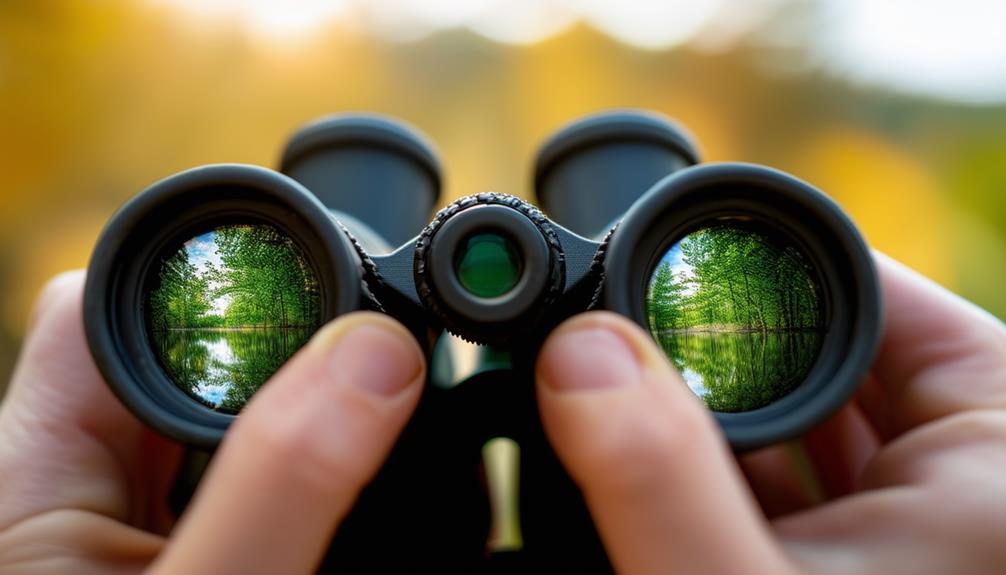
To achieve the sharpest possible picture, start by using the center focus knob to make small adjustments while keeping both eyes open. Begin with a high-contrast object at a distance, such as a tree against the sky, to help you detect subtle changes in clarity.
Next, close your right eye and focus solely on the left eyepiece. Use the center focus knob to bring the image into sharp focus. Once the left eye is set, switch your attention to the right eye.
Close your left eye and open your right eye. Adjust the diopter setting on the right eyepiece to bring the image into focus for your right eye. This step ensures independent focusing, guaranteeing that both eyes see an equally sharp picture.
After adjusting the diopter, open both eyes and use the focus ring to fine-tune the overall clarity. Continue adjusting the diopter and focus ring until the image is crisp and clear for both eyes. Proper diopter settings significantly enhance viewing comfort and reduce eye strain. Precise, independent focusing for each eye is essential for optimal viewing comfort. Happy birdwatching or stargazing!
Cleaning and Maintenance
Regularly clean the lenses with a microfiber cloth to keep your binoculars in excellent condition. This simple step ensures clear, sharp images and prevents dirt from affecting the diopter setting and focal length. When not in use, store your binoculars in a protective case to avoid dust and debris buildup.
To maintain peak image quality, avoid direct contact with the lenses. Here are some tips for cleaning and maintenance:
- Use a microfiber cloth: Gently wipe the lenses to remove smudges and fingerprints.
- Store in a protective case: Prevents dust and debris accumulation.
- Check for misaligned barrels: Ensure barrels are parallel to avoid viewing discomfort.
- Tighten loose parts: Regularly check and tighten screws for smooth operation.
These steps will keep your binoculars functioning smoothly and extend their lifespan. Well-maintained binoculars make adjustments easier and more effective. Periodically inspect them for any issues that could affect the diopter setting or focal length, especially if you wear eyeglasses. Proper cleaning and maintenance are crucial for enjoying crystal-clear views every time you use your binoculars.
Troubleshooting Common Issues
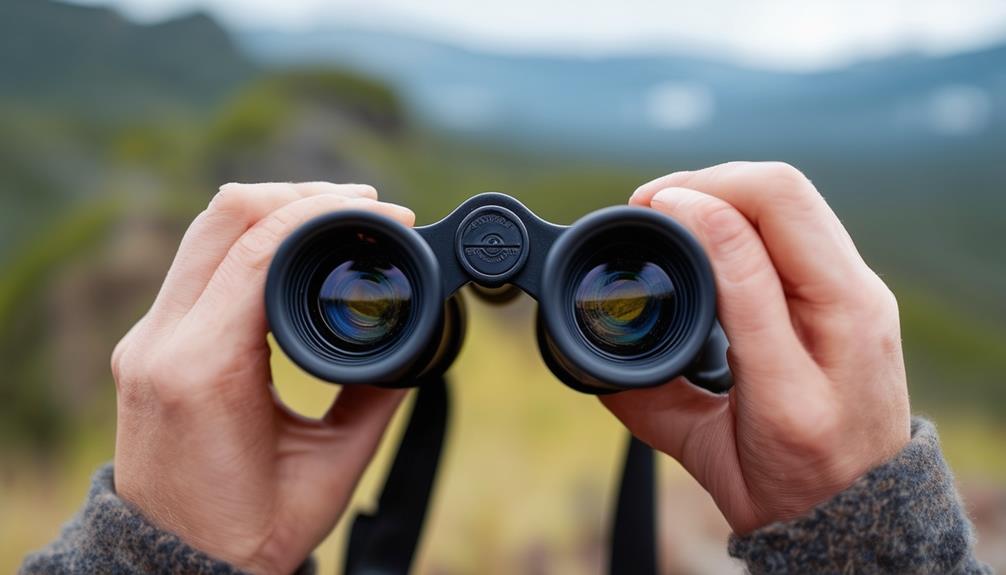
When troubleshooting common issues with your binoculars, start by addressing double vision. This can often be fixed by checking the alignment and adjusting the interpupillary distance. Ensure your lenses are clean to avoid distorted images, and use the diopter adjustment ring to fine-tune the focus for clear vision. Lastly, tighten any loose screws and test your binoculars in various lighting conditions to resolve any remaining visibility problems.
Double Vision Solutions
Dealing with double vision in binoculars can be frustrating, but it's often fixable by addressing misaligned barrels or incorrect diopter settings.
Here are steps to help you resolve double vision issues:
Align the Barrels: Ensure both barrels are perfectly aligned. Misalignment can cause each eye to perceive a slightly different image, leading to double vision.
Adjust the Diopter Setting:
- Cover one lens and use the diopter adjustment to focus on a clear object.
- Switch eyes and repeat the process. This helps each eye achieve individual clarity.
Set the Interpupillary Distance:
- Adjust the distance between the two eyepieces to match your eye spacing. Incorrect spacing can cause strain and double vision.
Fine-tune the Focus:
- After setting the diopter, use the central focusing wheel to sharpen the image for both eyes.
Inspect for Smudges or Loose Parts:
- Check for dirt on the lenses or loose screws. Cleaning and tightening can resolve visual disturbances.
If these steps don't resolve the issue, it may be necessary to seek professional calibration for your binoculars.
Lens Cleaning Tips
Maintaining clean binocular lenses is crucial for clear and sharp images. Use a microfiber cloth to gently remove smudges and dust, as these cloths are designed specifically to avoid scratching the lens surface. Refrain from using tissues or paper towels, which can leave fibers and cause minor scratches.
Always store your binoculars in a protective case when not in use to prevent dirt and scratches. This practice helps keep debris off the lenses and protects them from accidental damage. For persistent smudges, dampen the microfiber cloth with a lens cleaning solution instead of applying the liquid directly to the lenses.
Avoid touching the lenses with your fingers, as the oils from your skin can leave difficult-to-remove fingerprints and distort your view. Regular lens cleaning ensures optimal clarity and prevents buildup that could impair your viewing experience. By following these tips, you'll maintain pristine lenses and enjoy the best possible image quality every time you use your binoculars.
Fixing Focus Problems
Achieving a clear view through your binoculars often requires addressing common focus issues that can develop with regular use. Here's a step-by-step guide to resolving these problems:
- Diopter Adjustment: Start by using the diopter to compensate for any differences between your eyes. Close your left eye and use the center focus knob to sharpen the image for your right eye. Then, close your right eye and adjust the diopter until the image is clear for your left eye. This ensures each eye is properly focused.
- Additional Troubleshooting Tips:
- Depth of Field: Ensure you aren't trying to focus on objects that are either too close or too far away, as binoculars have a specific depth of field.
- Dirty Lenses: Clean your lenses regularly with a microfiber cloth to prevent smudges and debris from distorting your view.
- Misaligned Barrels: Check for misalignment, which can cause double vision and discomfort.
- Eyecup Adjustment: Adjust the eyecups to suit your needs, especially if you wear glasses.
Using a Tripod
Mounting your binoculars on a sturdy tripod stabilizes them for extended viewing sessions, eliminating hand fatigue and ensuring clear, precise observations, especially with high magnification models.
A tripod allows for hands-free operation, letting you focus on intricate details without needing to constantly adjust for shakiness. This stability enables you to keep your binoculars fixed on a specific spot, enhancing viewing comfort and reducing strain on your arms and shoulders.
The enhanced stability also creates a more relaxed and enjoyable experience, whether you're bird watching, stargazing, or surveying landscapes. Improved viewing comfort and clarity enable you to appreciate finer details that might otherwise go unnoticed. Incorporating a tripod into your setup ensures each session is comfortable and visually rewarding, fully utilizing your high magnification binoculars.
Advanced Calibration Tips
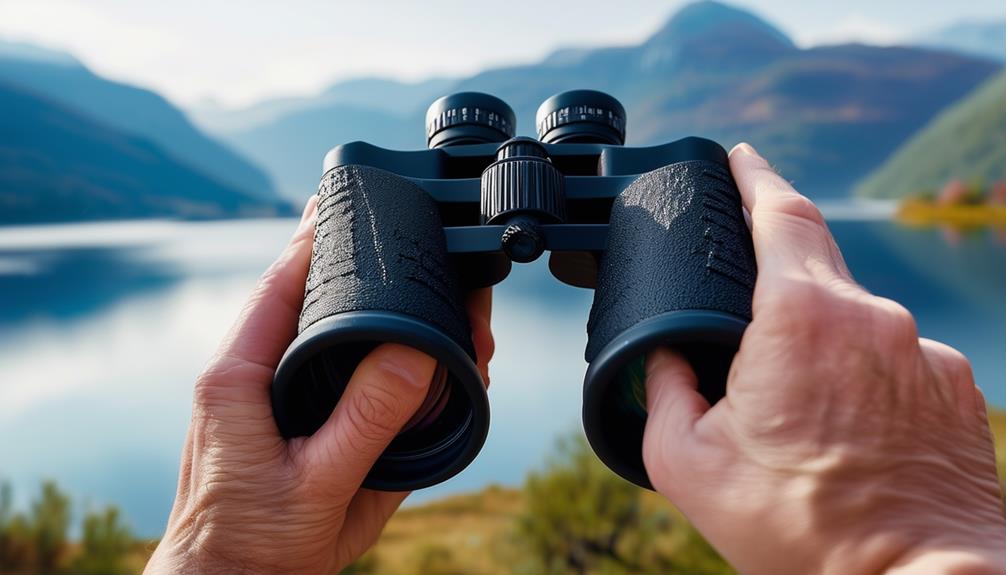
To optimize the performance of your binoculars, experiment with different eyecup positions to enhance comfort and clarity. Proper eyecup adjustment can significantly reduce eye strain and improve your viewing experience.
For advanced calibration, follow these steps:
- Use a Tripod: Ensure stability to make precise adjustments without the interference of hand tremors.
- Focus on a Distant, High-Contrast Object: Select an object like a tree trunk to fine-tune the focus and diopter settings accurately.
- Adjust the Eyecups: Find the most comfortable position to prevent eye strain.
- Fine-Tune the Focus: Use distant high-contrast objects to achieve the clearest image.
- Set the Diopter: Adjust the diopter for precise clarity using the same high-contrast object.
These tips will help you achieve ideal calibration for your binoculars, ensuring a clear and comfortable viewing experience.
Professional Calibration Services
For an optimal viewing experience, consider professional calibration services to ensure your binoculars are precisely adjusted to your vision needs. Experts can fine-tune your binoculars, enhancing clarity and comfort by adjusting key elements such as diopter settings, interpupillary distance, and focus.
By choosing professional calibration, you'll benefit from the expertise of trained technicians who understand the intricacies of binocular adjustments. They'll ensure your diopter settings are accurately balanced, addressing any differences in vision strength between your eyes, which is crucial for improving image sharpness.
Adjusting the interpupillary distance is another essential aspect of calibration. Professionals will measure and set this distance to match the spacing of your eyes, enabling a clear, strain-free image. Additionally, they'll fine-tune the focus mechanism, allowing you to seamlessly switch between near and distant objects with crisp clarity. Seek professional assistance to enhance both the comfort and enjoyment of using your binoculars. Expert calibration will make your viewing experience clearer, sharper, and more enjoyable.
Conclusion
You've now mastered the basics of adjusting your binoculars for optimal viewing comfort. Start by setting the eye cups to the appropriate position, adjust the width to match your eyes' distance, and fine-tune with the diopter adjustment.
Keep your lenses clean for clear images and consider using a tripod for added stability. If you encounter any issues, troubleshoot or seek professional calibration. With these tips, you'll enjoy a crystal-clear viewing experience every time. Happy observing!

